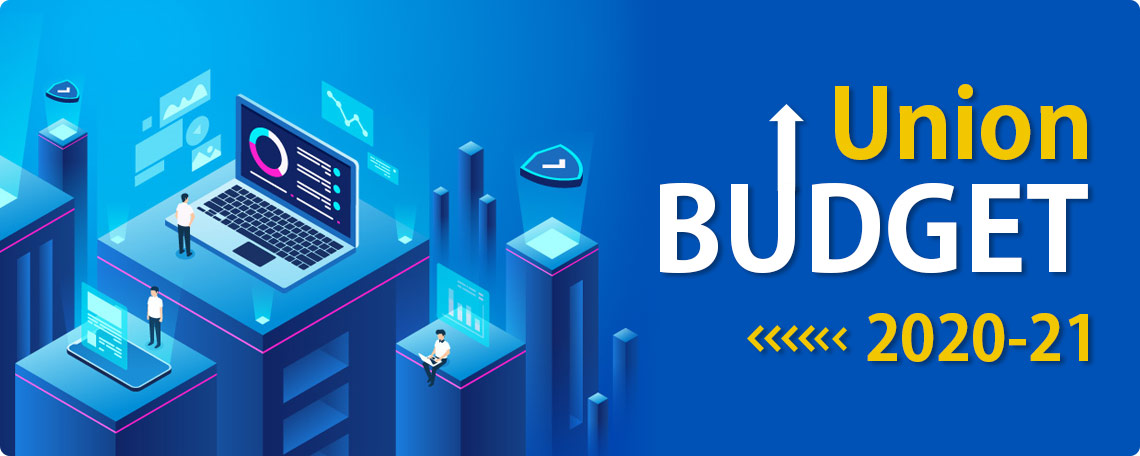stockaxis Market Intelligence (Commentary for January 2020; Outlook for February 2020)
February 14, 2020
|
We are pleased to present to you our monthly market commentary and outlook for the forthcoming month. The ‘stockaxis’ Market Intelligence’ is a quick update on the markets for the month gone by and our view for the next month. Use our sharp and crisp synopsis to continue building your wealth!
Budget 2020-21
At 11 am on 1st February, 2020 Saturday, India’s Finance Minister, Ms Nirmala Sitharaman rose before a full house of the parliament and requested the speaker to permit her to present the Union Budget for the year 2020-2021.
Progress so Far
Starting with reconfirming the present government’s commitment to serve the people of India with humility and dedication, she clearly stated that the intent of the current budget is to boost people’s incomes and enhance their purchasing power. She emphasized the need to have India’s youth gainfully employed and evolve businesses to be innovative, healthy and solvent with use of technology. She stated that the budget aspired to have the aspirations and hopes of every Indian citizen addressed.
She listed out the government’s achievements so far of inclusive growth, controlling inflation, cleaning up the banks’ books and recapitalizing them, formalizing the economy, and implementing the Goods and Services Tax (GST).
On the GST initiative, she stated that this had brought about efficiency by consolidating numerous taxes and cesses to one tax and had facilitated formalization of the economy. GST had a significantly positive impact on the logistic and transport sectors with turnaround time for trucks falling by 20% due to abolition of check posts. GST has reduced tax burden on consumers by 10% and an average household now saves about 4% on its monthly spends on account of lower GST rates.
The Finance Minister noted other reforms carried out by the government - (a) welfare schemes with Direct Benefit Transfer (DBT); (b) sanitation and water as provision of basic needs and as a measure of preventive healthcare; (c) healthcare, through Ayushman Bharat; (d) clean energy through Ujjwala and solar power; (e) financial inclusion, credit support, insurance protection to vulnerable sections and pension scheme; (f) digital penetration with broadband and UPI;(g) Affordable Housing for all through PMAY.
The Finance Minister stated that India was now the fifth largest economy of the world and our foreign direct investments rose to US$ 284 billion during 2014-19 from US$ 190 billion during 2009-14. Central Government debt reduced to 48.7% of GDP in March 2019 from 52.2% in March 2014. The Finance Minister stated that India’s nominal GDP for year 2020-21 was at 10%.
Ms Sitharaman then stated that she was presenting the budget in the backdrop of two cross-cutting developments:
- Proliferation of technologies, specially analytics, machine learning, robotics, bio-informatics and Artificial Intelligence; and
- The number of people in the productive age group i.e. 15-65 years in India, being at its highest.
Her budget is structed under 3 prominent themes:
- Aspirational India in which all sections of the society seek better standards of living, with access to health, education and better jobs.
- Economic development for all through reforms across different areas of the economy. With the support of the private sector, the government would ensure higher productivity and greater efficiency.
- A Caring Society that is both humane and compassionate.
In summary, she stated that her budget aimed to provide “Ease of Living” to all citizens. She pledged an India that was corruption free, policy-driven with good governance and a clean and sound financial sector.
Aspirational India
Under this initiative, she covered programmes related to: (1) Agriculture Irrigation and Rural development (2) Wellness, Water and Sanitation and (3) Education and Skills
Agriculture, Irrigation and Rural Development
The government is committed to the goal of doubling farmers’ incomes by 2022. By providing farmers energy, inputs, insurance, micro irrigation and financial inclusion through various plans of the government, the farmer has become independent and resilient. The government is facilitating prosperity to the farmer by making farming competitive through liberalisation, removing distortions in farm and livestock markets, using technology to improve produce and providing logistics, storage, financing, processing and marketing.
The central government has initiated the following model laws which she hoped the state governments would implement.
- Model Agricultural Land Leasing Act, 2016
- Model Agricultural Produce and Livestock Marketing (Promotion and Facilitation) Act, 2017; and
- Model Agricultural Produce and Livestock Contract Farming and Services (Promotion and Facilitation) Act, 2018
Other initiatives taken are:
- Taking comprehensive measures to provide relief to 100 water stressed districts.
- Providing 20 lakh farmers solar pumps and helping 15 lakh farmers solarise their grid-connected pump sets.
- Enabling farmers to set up solar power generation capacity on their fallow/barren lands and sell this power to the grid to earn from such land.
- Reducing excessive use of chemical fertilizers by encouraging use of organic and other innovative fertilizers.
- Geo-tagging India’s 162 million MT capacity of agri-warehouses, cold storage, reefer van facilities etc.
- Creating new warehouses as per Warehouse Development and Regulatory Authority (WDRA) norms at the block/taluk level.
- A Village Storage scheme will be set up and run by the Self Help Groups (SHGs) to provide farmers a good holding capacity and reduce their logistics cost.
- Indian Railways will set up a ‘Kisan Rail’ through PPP to build a seamless national cold supply chain for perishables, inclusive of milk, meat and fish.
- Flight facilities to transport produce under KrishiUdaan on international and national routes.
- She stated that the current produce of the Horticulture sector exceeded that of food grains. The government would support States adopting a cluster basis - “one product one district” with better marketing and exports.
- The government wants to provide credit to the agricultural sector through NBFCs and cooperatives, and has set a target at Rs. 15 lakh crore for the year 2020-21.
- Milk capacity to be doubled from 53.5 million MT to 108 million MT by 2025 through artificial insemination.
- Creating a framework for development, management and conservation of marine fishery resources.
- Raising fish production by 200 lakh tonnes which productively employs youth residing in coastal areas. Raising fishery exports to Rs. 1 lakh crore by 2024-25.
Healthcare
The Finance Minister stated that the government had a holistic vision of healthcare for all Indians that covered fighting diseases, providing safe water and comprehensive sanitation program. This involved expanding the number of empanelled hospitals from the present 20,000 and setting up more hospitals in Tier-2 and Tier-3 cities. This would provide large scale employment for the youth. The government has committed to end Tuberculosis by 2025.
The government aspires to provide piped water supply to all households by augmenting local water sources, recharging existing sources and promoting water harvesting and de-salination.
Education and Skills
The government has recognized that India will have the largest working age population by 2030 and will announce a New Education Policy shortly. To fund the education system to attract talented teachers and provide better infrastructure, a combination of External Commercial Borrowings and FDI will be tapped into.
The government proposes to instruct urban local bodies across the country to provide internship opportunities to fresh engineers for a period up to one year.
To provide education to students in the deprived sections, a few of the top 100 National Institutional Ranking institutes will be requested to provide degree programmes online.
Textiles
The Finance Minister proposes to reverse India’s textile imports by making India a global leader in Technical Textiles by setting up a National Technical Textiles Mission.
Exports
Higher insurance coverage with reduction in premium will be provided for small exporters and simplified procedure for claim settlements.
Refunds of duties and taxes will be made digitally to exporters.
To boost exports, the government will provide support to export-oriented sectors such as IT, pharma, auto, etc. in the form of technology upgradations, R&D, business strategy etc. and funding through EXIM Bank and SIDBI.
MSMEs
Government e-Marketplace (GeM) is creating a Unified Procurement System in the country for providing a single platform for procurement of goods, services and works. It offers a great opportunity for Medium, Small and micro Enterprises (MSMEs). 3.24 lakh vendors are already on this platform. Its proposed to take its turnover to Rs. 3 lakh crore.
MSMEs with turnover of more than Rs. 1 crore had to get their books of accounts audited. The Finance Minister has raised this to Rs. 5 crore for those businesses which carry out less than 5% of their business transactions in cash.
Infrastructure
Rs. 103 lakh crore will be invested in infrastructure. It consists of more than 6,500 projects across sectors and are classified as per their size and stage of development. These new projects include housing, safe drinking water, access to clean and affordable energy, healthcare for all, world-class educational institutes, modern railway stations, airports, bus terminals, metro and railway transportation, logistics and warehousing, irrigation projects, etc. A huge employment opportunity exists for India’s youth in construction, operation and maintenance of infrastructure. National Skill Development Agency will give special thrust to infrastructure-focused skill development opportunities.
Culture & Tourism
Growth of tourism directly relates to growth and employment. States have a critical role to play.
India has moved up from rank 65 in 2014 to 34 in 2019 in the Travel & Tourism Competitive Index (World Economic Forum). Foreign exchange earnings grew 7.4% to Rs.1.88 lakh crore for the period January to November 2019 from Rs.1.75 lakh crore.
Financial Sector
The government has consolidated 10 banks into 4 and has so far, infused about Rs. 3,50,000 crore by way of capital into PSU banks for regulatory and growth purposes.
Insurance on bank deposits by the Deposit Insurance and Credit Guarantee Corporation (DICGC) has been increased from Rs. 1 lakh to Rs. 5 lakh per depositor.
The limit for NBFCs to be eligible for debt recovery under the Securitization and Reconstruction of Financial Assets and Enforcement of Security Interest (SARFAESI) Act 2002 is proposed to be reduced from Rs. 500 crore to asset size of Rs. 100 crore or loan size from existing Rs. 1 crore to Rs. 50 lakh.
The government will sell its balance holding in IDBI Bank to private, retail and institutional investors through the stock exchange.
The government will initiate Universal Pension coverage with auto enrolment. The regulating role of PFRDAI will be strengthened.
Disinvestment
The government now proposes to sell a part of its holding in LIC by way of Initial Public Offer (IPO).
Insurance
The insurance sector is expected to experience a number of changes as a result of Budget 2020 announcements. With LIC, the largest insurance company in terms of Assets Under Management (AUM), likely to be listed, it will be the largest company in terms of market value. LIC’s listing is expected to bring about transparency and efficiency across the life insurance sector. On the negative side, under the new tax laws, section 80C, which offers tax deduction on premiums paid on life insurance policies, is not longer available. This could be a disincentive to policyholders. However, over the long term, insurance will be purchased for protection and not for tax saving, which is the true intention of purchasing insurance.
Personal Income Tax and simplification of taxation
New proposed tax structure is as follows:
| Taxable Income Slab (Rs.) | Existing Tax Rates | New Tax Rates |
|---|---|---|
| 0-2.5 Lakh | Exempt | Exempt |
| 2.5-5 Lakh | 5% | 5% |
| 5-7.5 Lakh | 20% | 10% |
| 7.5-10 Lakh | 20% | 15% |
| 10-12.5 Lakh | 30% | 20% |
| 12.5-15 Lakh | 30% | 25% |
| Above 15 Lakh | 30% | 30% |
In the new tax regime, a person earning Rs. 15 lakh in a year and not availing any deductions etc. will pay only Rs. 1,95,000 tax as compared to Rs. 2,73,000 in the old regime. Thus, his tax burden shall be reduced by 78,000 in the new regime. He would still be the gainer in the new regime even if he was taking deduction of Rs. 1.5 lakh under various sections of Chapter- VI-A of the Income Tax Act under the old regime.
The new tax regime shall be optional for the taxpayers.
The number of tax exemptions and deductions has been reduced from more than 100 to about 30.
Dividend Distribution Tax
Dividends will now be taxed in the hands of recipients (shareholders). Dividend Distribution Tax (DDT) is proposed to be abolished.
Concessional tax rate for new companies
New manufacturing companies will be levied a concessional corporate tax rate of 15% if they start manufacturing by 31st March, 2023.
New electricity generation companies will be levied a concessional corporate tax rate of 15%.
Tax concession for foreign investments
Foreign investors investing in the infrastructure and other notified sectors will be given 100% tax exemption to their interest, dividend and capital gains provided they invest before 31st March, 2024 and with a minimum lock-in period of 3 years.
Start-ups
Employee Stock Option Plan (ESOP), which are currently taxable as perquisites at the time of exercise, will now be taxed on the employees after five years or when they leave the company or when they sell their shares, whichever is earliest.
Currently, an eligible Start-up with turnover of up to Rs. 25 crore is allowed deduction of 100% of its the profits for 3 consecutive assessment years out of 7 years if the total turnover does not exceed Rs. 25 crore. The turnover limit is now increased to Rs. 100 crore and the number of years is proposed to be increased from 7 to 10 years.
Affordable housing
Under the ‘affordable housing’ category, an additional tax deduction of Rs.1.5 lakh for interest paid on home loan was offered in the last budget. This has been extended for one more year.
Developers of affordable houses will get a tax holiday on profits earned in affordable housing projects approved by 31st March, 2021.
Concession to real estate transactions
Currently, while taxing income from capital gains, business profits and other sources for real estate transactions, if the consideration value is less than the circle rate by more than 5%, the difference is counted as income both in the hands of the purchaser and seller. This has been increased to 10% to provide relief to the sector.
Faceless appeals
To bring transparency in tax assessments, the government has initiated a faceless assessment scheme enabling faceless appeal on the lines of faceless assessment.
Tax amnesty scheme
The Finance Minister announced a tax scheme where an asseessee facing a tax dispute would be required to pay only the amount of the disputed taxes and will get complete waiver of interest and penalty provided he pays by 31st March, 2020.
Losses of merged banks
The Finance Minister stated that with the government merging PSU banks, in order to help the banks take benefit of unabsorbed losses and depreciation, necessary amendments in the Income-tax Act would be made.
Indirect Tax
- Customs duty is being raised on items like footwear and furniture.
- Customs duty will be imposed on imports of medical equipment.
- Customs duty rates are being revised on electric vehicles, and parts of mobiles.
- Customs duty on imports of news print and light-weight coated paper reduced from 10% to 5%.
- Anti-dumping duty on PTA is being abolished.
- Excise duty on Cigarettes and other tobacco products raised. No change is being made in the duty rates of bidis.
- To conclude, the budget holds a promise to Indians that the government is committed to providing Indians with prosperity, health and a better life.




